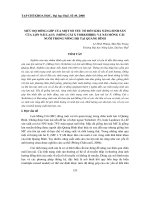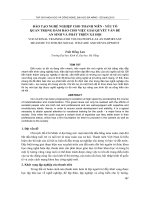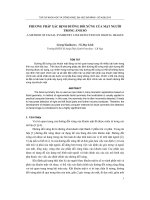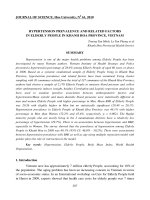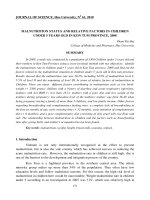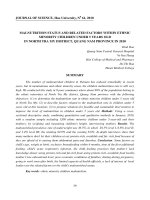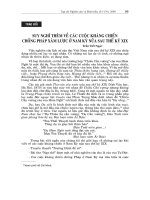Báo cáo nghiên cứu khoa học: "Tình trạng suy dinh dưỡng và các yếu tố liên quan ở trẻ em dưới 5 tuổi ở tỉnh Kon Tum năm 2008" pot
Bạn đang xem bản rút gọn của tài liệu. Xem và tải ngay bản đầy đủ của tài liệu tại đây (11.36 MB, 11 trang )
131
JOURNAL OF SCIENCE, Hue University, N
0
61, 2010
MALNUTRITION STATUS AND RELATIVE FACTORS IN CHILDREN
UNDER 5 YEARS OLD IN KON TUM PROVINCE, 2008
Pham Thi Hai
College of Medicine and Pharmacy, Hue University
SUMMARY
In 2008, a study was conducted in a population of 1500 Children under 5 years old and
their mothers in Kon Tum Province using a cross-sectional method with two objectives: identify
the malnutrition rate in children under 5 years old in Kon Tum province, 2008 and find out the
factors related to the malnutrition situation in children under 5 years old in Kon tum province.
Results showed that the malnutrition rate was 30.2%, including 24.2% of malnutrition level I;
5.5% of level II and the remaining of level III. In terms of relative factors of malnutrition in
Children. There are many different factors contributing to malnutrition such as low birth-
weight (< 2500 gram); children with a history of diarrhea and acute respiratory infections;
mothers with low BMI (< less than 18.5); mothers with a poor diet and low weight of the
mothers during pregnancy; low education level of the mothers; mother’ age from 36-49 when
being pregnant; having a family of more than 3 children; and low family income. Other factors
regarding breastfeeding and complementary feeding were: a complete lack of breastfeeding in
the first six months of age; early weaning time (< 12 months); early initiation of complementary
diet (< 6 months); and a poor complementary diet consisting of only gruel with rice flour and
salt. The relationship between malnutrition in children and the factors such as breastfeeding
time after giving birth, and mother’s occupation has not been found.
Key words: malnutrition, weight, height, breast milk, weaning, related.
1. Introduction
Vietnam is not only internationally recognised in the effort to prevent
malnutrition, but is also the sole country which has achieved success in reducing the
acute malnutrition rate. However, the malnutrition rate in children is still high, this is
one of the barriers to the development and integration process of the country.
Kon Tum is a highland province in the northern central area. The ethnic
minority group makes up more than 54% of the population. They often have low
education levels and follow traditional customs. For this reason, the high risk level of
malnutrition in children here would be unavoidable. Weight malnutrition rate in children
under 5 according to an investigation in 2007 was 31%, which was relatively high in
132
comparison with other provinces. There is a considerable gap between this figure and
the required target of national nutrition strategy to be reached by late 2010. Monitoring
the annual malnutrition rate along with investigating and evaluating associated risk
factors are important activities develop appropriate solutions for preventing malnutrition
in the future. As a result, we conduct the study: “Malnutrition status and relative factors
in children under 5 years old in Kon Tum province, 2008”.
Study objectives is to identify the malnutrition rate in Children under 5 years
old in Kon Tum province, 2008 and investigate the factors related to the malnutrition
situation in Children under 5 years old in Kon Tum province.
2. Methodology
2.1. Subjects and Research Time
Study participants were all under 5-year-old children born from 01/11/2003 to
31/10/2008 and their mothers in Kon Tum.
The study was conducted between July 2008 and October 2008 in all 9 suburban
districts of the province.
2.2. Research method: The study used a cross-sectional descriptive method
2.2.1 Sample size:
The sample size is calculated based on the formula, as following:
2
2/
2
)1(
d
pp
Zn
Where:
n: Number of researched children
Confident interval: 95%, Z /2 =1,96
p: Estimated malnutrition rate, p = 31,5% is malnutrition rate of the year
2007 in Kon Tum
3
.
d: Standard error, d = 0,25
Therefore, the minimum sample size is 1326 children.
Adding 15% for refusals and attrition, the study sample size is 1500 children.
2.2.2. Selecting the sample:
The study used a multi–stage random sampling method.
2.2.3. Collecting data:
- Children: date of birth, gender, birth-weight, breastfeeding status,
133
complementary diet, disease status, and anthropometric measurements
- Mother: age, education level, occupation, ethnic group, family income,
drinking and eating habit, number of children and anthropometric measurement
2.2.4. Collecting data techniques:
- Identifying children under 5 years of age: estimating their age based on the
nearest month and year.
- Idetifying athropometric measurements: measuring weight and height as
normal rule.
- Collect information about relative factors by directly interviewing mothers (or
guardians) using a structured questionnaire.
2.2.5. Indicators to evaluate nutritional status in children:
Three anthropometric measurements are Weight-for-age, Height-for-age and
Weight-for-height. The study results were on the basis of reference data of the U.S
National Center for Health Statistics (NCHS); A negative standard deviation (-2SD) is
considered as malnutrition.
2.3. Data analysis method:
The study used EPI INFO and SPSS software to determine the malnutrition rate
according to adjusted age and gender. Test
2
was used to compare the indicators.
3. Results
3.1. Malnutrition rate:
Table 3.1. Underweight- for-age malnutrition rate
Age (month) n
Number of
Children
Percentage
%
p
0- < 12 332 42 12.7
<0.001
12 - < 24 354 138 39.0
24- < 36 305 118 38.7
36- < 48 212 68 32.1
48- < 60 297 87 29.3
Total 1500 453 30.2
The underweight malnutrition rate of children in Kom Tum, in 2008 is 30.2%,
which is still relatively high compared with 19.9% of the national malnutrition rate.
This figure is also considered as at very high level according to the WHO’s
134
classification. Therefore, to achieve the required target of the national nutrition strategy
of 2001-2010, it is necessary for Kon Tum province to improve the economic conditions
and education levels in the effort of reducing the malnutrition rate in children to 20% by
2010.
Figure 3.1. underweight-for-age malnutrition rate in children.
Malnutrition in children often happens in the first year of life (12.7%) and
increases in accordance with the age group. The highest malnutrition risk was found in
children within the age group of 12 to 36 months, which then continues at a high level
until under 60 months (29.3%). This finding is comparable with the investigation of the
Nutrition Institution and Phan Van Hai but different with the studies which were
implemented in plain areas, which showed that the highest malnutrition rate is at the
group of 48 to 60-month old.
Table 3.2. Stunting-for-age malnutrition rate
Age (month) n
Number of
Malnutrition
case
Percentage
%
p
0- < 12 332 81 24.4
<0.0001
12 - < 24 354 192 54.2
24- < 36 305 143 46.9
36- < 48 297 140 47.1
48- < 60 212 112 52.8
Total 1500 668 44.5
The stunting malnutrition rate in children under 5 years old in Kon Tum is much
higher than in the whole country and at a very high level according to the WHO
135
classification
1
. Stunting in children under 5 years old appears early in the first year of
life (24.4%) and booms in the age group of 12 to under 24 months, and is then
constantly maintained at high levels until under 60 months; There is a significant
difference in the stunting malnutrition rate among age groups (figure 3.2). This outcome
is similar to the study of Phan Van Hai. The Nutrition Institution, and some other
researchers.
Figure 3.2. Stunting-for-age malnutrition rate
Table 3.3. Wasting-for-age malnutrition rate
Age (month) n
Number of Malnutrition
case
Percentage %
p
0- < 12 332 28 8.4
<0.001
12 - < 24 354 39 11.0
24- < 36 305 22 7.2
36- < 48 212 6 2.8
48- < 60 297 8 2.7
Total 1500 103 6.9
The highest wasting-for-age malnutrition rate is in the 12 to under 24-month-old
group. This figure will gradually decrease when children grow up. There is a statistical
difference with p<0.001.
136
Figure 3.3.Wasting-for-age malnutrition rate
According to Ha Huy Khoi, the wasting malnutrition rate is often at the highest
level when children are 2 years old. This is an age group which is weaning and
switching to the diet of an adult person. Therefore, poor diet along with diseases can
lead to wasting in children.
Table 3.4. Classification of malnutrition according to level
Malnutrition level Level 1 Level 2 Level 3
Underweight (%) 24.2 5.5 0.5
Stunting (%) 28.8 15.7
Almost malnourished children is in level 1; Malnutrition level is just 0.5%.
Table 3.5. Classification of stunting- for-gender malnutrition rate
Gender n
Underweight
malnutrition rate %
Stunting
malnutrition
rate%
SDD thấp còi %
Male 729 30.3 45.5 8.1
Female 771 30.1 43.6 5.7
p>0.05
The difference between boys and girls in all of three type of malnutrition is
insignificant. This result is comparable to the researchers.
137
Table 3.6. Classification of malnutrition rate according to rate
Race n
Underweight
malnutrition rate %
Stunting
malnutritio
n rate%
Wasting
malnutrition
rate %
Kinh group 183 18.6 31.7 3.8
Minority ethnic
group
1317 31.8 46.3 7,.3
p <0,001 p <0,001
The malnutrition rate in ethnic minority children is much higher than than in
Kinh children in all 3 types of malnutrition. This difference is statistically significant
with p<0.001. This result is similar to Phan Van Hai’s study and other researchers.
Table 3.7. Malnutrition rate of the combination of HFA and WFH
Indicators HFA WFH WFH & HFA
Malnutrition rate 707 103 37
Percentage % 47.1 6.9 2.5
There are 2.5% of children in malnutrition status of stunting and wasting
symptom.
3.2. Factors relative to malnutrition status
Table 3.8. The relationship between studied factors and malnutrition status
Studied factors
%
Malnut
rition
rate
%
nutrition
rate
p
Mother’s diet during
pregnancy
Lack of food 37.1 62.9
<0.001
normal & greater than 27.9 72.1
Weight increase of
mother during
pregnancy
<10kg 35.9 64.1
<0.001
10kg 16.4 83.6
Birth-weight
< 2500g 52.0 48.0
<0.001
2500g 28.4 71.6
breastfeeding Yes 76.9 23.1 <0.001
138
No 27.6 72.4
Pre-lacteal feed
early ( 1 hour) 29.7 70.3
> 0.05
late (>1 hour ) 31.6 68.4
Breastfeeding in the
first 6 months of age
Completely not 31.3 68.7
< 0.05
Completely 24.9 75.1
Initiation of
complementary diet
<6 months 36.6 63.4
< 0.05
6 months 28.8 71.2
Food types
gruel, rice flour 44.8 55.2
< 0.05
mixed 31.0 69.0
Weaning time
<12 months 52.2 47.8 <0.001
12 months 32.9 67.1
Malnutrition is associated with diet and the weight increase of mother during
pregnancy, birth-weight, completely breastfed within 6 months of age, complementary
diet, early weaning (p<0.001). Our outcomes are rational with the researchers.
Table 3.9. The relationship between children with medical history of diarrhea and fever along
with bad cough and malnutrition
Medical history
Malnutrition
rate %
Nutrition rate % p
Diarrhoea
Yes 39.6 60.4
p <0.001
No 28.2 71.8
Fever and cough
Yes 38.5 61.5
p <0.001
No 26.9 73.1
Malnutrition is notably related to children with a medical history of diarrhea and
fever along with bad cough (p < 0.001). This result is in accordance with other research.
Table 3.10. Other relative factors and malnutrition rates in Children
Factors
Malnutriti
on rate %
Nutrition
rate %
p
Education level of
mother
illiteracy 41.5 58.5
p <0.0001
Primary school 31.9 68.1
139
second
school
19.5 80.5
Occupation of mother
Agriculture 32.0 68.0
> 0.05
Trader 24.6 75.4
Officer 23.9 76.1
Housewife 27.7 72.3
BMI of mother < 18,5 35.4 64.6
<0.001
18,5 26.8 73.2
Mother age 36- 49 34.3 65.7
<0.05
20- 35 28.6 71.4
Number of children 3 children 34.3 65.7
<0.001
2 Children 25.6 74.4
Family income Poor 37.2 62.8
<0.001
Not poor 27.6 72.4
There is a correlation between malnutrition in children and other factors such as
the education level of the mothers, BMI of the mothers, mothers’ age, their number of
children and family income. The difference has statistical meaning with p<0.05-0.001.
Our results are comparable with other research.
The occupation of mothers is statistically linked with malnutrition in children in,
which is also reported by other researchers.
4. Conclusion
Through the study of a population of 1500 under 5-year-old children and their
mothers of in Kon Tum, we found the following results:
Malnutrition status in Children:
The malnutrition rate is 30.2%, including 24.2% of malnutrition level ®, 5.5%
of level II and the remaining of level III.
The group of babies from 12 to less than 24 month-old occupies the highest
malnutrition rate, consisting of types of stunting, underweight and wasting.
The height-for-age malnutrition rate is at a very high level of 44.5% and weight-
for-height malnutrition rate is 6.9%; the malnutrition rate of children who contract both
stunting and wasting symptom is 2.5%.
140
There was indifferences between malnutrition rate of boys and girls (p>0.05).
The malnutrition rate was significantly different in statistics between Kinh
children and ethnic minority children. The underweight malnutrition rate of Kinh
children and ethnic minority children is 18.6% and 31.8% respectively (p <0.001). The
stunting malnutrition rate is 31.6% for the former and 46.3% for the latter (p<0.001)
Malnutrition-related factors in Children
There are many different factors contributing to malnutrition such as birth-
weight of children under 2500 gram; children with history of diarrhea and acute
respiratory infection; mothers’ BMI of less than 18.5; poor diet of the mother and low
weight of the mothers during pregnancy; low education level of the mothers; mothers’
age from 36-49 when being pregnant; having a family of more than 3 children and low
family income. Other factors about breastfeeding and complementary diet such as a
complete lack of breastfeeding in the first six months of age; weaning time is less than
12 months; initiation of complementary diet is under 6 months; and a poor
complementary diet consisting of gruel with rice flour and salt.
The relationship between malnutrition in children and the factors such as
breastfeeding time after giving birth, and mother’s career has not been found.
5. Recommendation
From above results, we propose some of the solutions to improve the
malnutrition status in children in the areas of Kon Tum province, as follows:
(1) Strengthen the communication and education about nutrition for the mothers
to improve knowledge of caring and feeding children, especially sick children.
(2) Improve health care and nutrition for women of childbearing age, especially
for pregnant women, and improvement in household income;
(3) Continue further research on specific risk factors causing malnutrition in
under 5-year-old children in Kon Tum particularly and the Central Highlands generally,
especially in ethnic minority children. From that point, we will have effective solutions
to diminish the rate of child malnutrition.
REFERENCES
1. Ministry of Health, Institute of Nutrition. Guidelines for evaluating the situation of
nutrition and food in the community. Hanoi: Medical Publisher 1998: 13-16, 59- 72.
2. Ha HK. Epidemiological methodology of Nutrition. Hanoi Medical Publisher 1997: 79-
83, 100-117.
3. Institute of Nutrition, General statistics Office, Results of nutrition status investigation
141
in children and mothers in 2002, Hanoi: Medical Publisher 2003.
4. WHO. Child Growth Standards: Training course on child growth assessment.
5. Phan VH. The study on malnutrition status in children under 5 year olds in Kon Tum
province in 2001 [Specialization level I’s thesis] - Hue: Hue Medical university. 2002.
6. Pham TH. Nutrition status and relative factors in children under 5 years old in Hai
Chanh commune of Hai Lang district in Quang Tri province [Master’s thesis of
Medicine] - Hue: Hue Medical university 2003.
7. Hoang TL. The study on malnutrition status and relative factors in children under 5
years old [Master’s thesis of Medicine] - Hue: Hue Medical university. 2001.
8. National Nutrition Strategy in 2001-2010. Hanoi: Medical Publisher. 2001.
9. Institute of Nutrition - Ministry of Health. The national nutrition conference in 2008.
2008: 12-20.
10. Tu G, Ha HK, Phan TK, Protein - Energy malnutrition, Pathological Encyclopediavol.1.
Hanoi: Encyclopedia Publisher 2000: 272 - 273.
11. Nguyen CK, Pham VH, Le DT. The progress of malnutrition in children from 1990 to
2004. Vietnamese medical journal 2007; 337( 1):37.
12.

